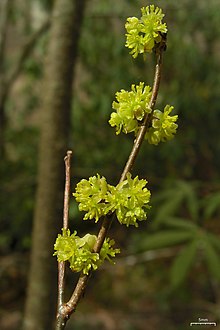Lindera benzoin
| Lindera benzoin | |
|---|---|
 |
|
| Scientific classification | |
| Kingdom: | Plantae |
| (unranked): | Angiosperms |
| (unranked): | Magnoliids |
| Order: | Laurales |
| Family: | Lauraceae |
| Genus: | Lindera |
| Species: | L. benzoin |
| Binomial name | |
|
Lindera benzoin L. |
|
 |
|
| Range within North America | |
| Synonyms | |
|
Benzoin aestivale |
|
Benzoin aestivale
Lindera benzoin (commonly called spicebush,common spicebush,northern spicebush,wild allspice, or Benjamin bush) is a shrub in the laurel family, native to eastern North America, ranging from New York to Ontario in the north, and to Kansas, Texas, and northern Florida in the center and south. Within its native range it is a relatively common plant where it grows in the understory in moist, rich woods, especially those with exposed limestone.
Spicebush is a deciduous shrub growing to 6–12 feet (1.8–3.7 m) tall. It has a colonial nature and often reproduces by root sprouting, forming clumps or thickets. The leaves are alternately arranged on the stem, simple, 6–15 cm (2–6 in) long and 2–6 cm (1–2 in) broad, oval or broadest beyond the middle of the leaf. They have a smooth edge with no teeth and are dark green above and paler below. The leaves, along with the stems are very aromatic when crushed with a spicy, citrusy smell, hence the common names and the specific epithet benzoin. In the fall the leaves turn a very bright and showy yellow color.
The yellow flowers grow in showy clusters which appear in early spring, before the leaves begin to grow. The flowers have 6 sepals and a very sweet odor. The ripe fruit is a red, elipsoidal, berrylike drupe, rich in lipids, about 1 cm (1⁄2 in) long and is eaten by several bird species. It has a "turpentine-like" taste and aromatic scent, and contains a large seed. Spicebush is dioecious (plants are either male or female), so that both sexes are needed in a garden if one wants drupes with viable seeds.
...
Wikipedia

